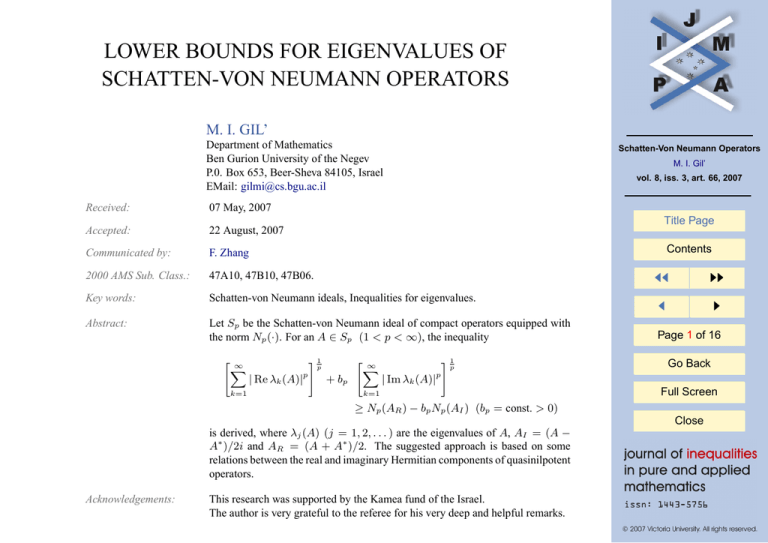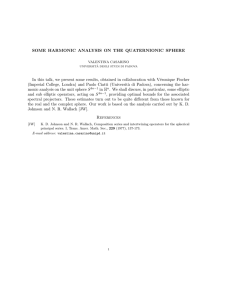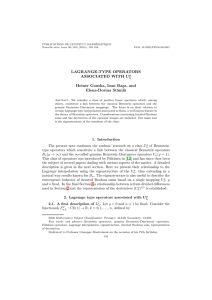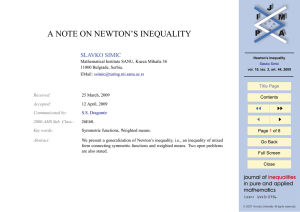LOWER BOUNDS FOR EIGENVALUES OF SCHATTEN-VON NEUMANN OPERATORS M. I. GIL’
advertisement

LOWER BOUNDS FOR EIGENVALUES OF
SCHATTEN-VON NEUMANN OPERATORS
M. I. GIL’
Department of Mathematics
Ben Gurion University of the Negev
P.0. Box 653, Beer-Sheva 84105, Israel
EMail: gilmi@cs.bgu.ac.il
Schatten-Von Neumann Operators
M. I. Gil’
vol. 8, iss. 3, art. 66, 2007
Received:
07 May, 2007
Accepted:
22 August, 2007
Communicated by:
F. Zhang
2000 AMS Sub. Class.:
47A10, 47B10, 47B06.
Key words:
Schatten-von Neumann ideals, Inequalities for eigenvalues.
Abstract:
Let Sp be the Schatten-von Neumann ideal of compact operators equipped with
the norm Np (·). For an A ∈ Sp (1 < p < ∞), the inequality
"∞
X
k=1
Title Page
Contents
#1
p
p
| Re λk (A)|
+ bp
"∞
X
#1
p
JJ
II
J
I
Page 1 of 16
Go Back
p
| Im λk (A)|
k=1
Full Screen
≥ Np (AR ) − bp Np (AI ) (bp = const. > 0)
Close
is derived, where λj (A) (j = 1, 2, . . . ) are the eigenvalues of A, AI = (A −
A∗ )/2i and AR = (A + A∗ )/2. The suggested approach is based on some
relations between the real and imaginary Hermitian components of quasinilpotent
operators.
Acknowledgements:
This research was supported by the Kamea fund of the Israel.
The author is very grateful to the referee for his very deep and helpful remarks.
Contents
1
Statement of the Main Result
3
2
Proof of Theorem 1.1
8
3
Additional Bounds
13
Schatten-Von Neumann Operators
M. I. Gil’
vol. 8, iss. 3, art. 66, 2007
Title Page
Contents
JJ
II
J
I
Page 2 of 16
Go Back
Full Screen
Close
1.
Statement of the Main Result
Let Sp (1 ≤ p < ∞) be the Schatten-von Neumann ideal of compact operators in a
separable Hilbert space H equipped with the norm
Np (A) := [Trace(A∗ A)p/2 ]1/p < ∞ (A ∈ Sp ),
cf. [4, 6]. Let λj (A) (j = 1, 2, . . . ) be the eigenvalues of A ∈ Sp taken with their
multiplicities. In addition, σ(A) denotes the spectrum of A, AI = (A − A∗ )/2i and
AR = (A + A∗ )/2 are the Hermitian components of A.
Recall the classical inequalities
j
X
p
|λk (A)| ≤
k=1
j
X
spk (A)
(p ≥ 1, j = 1, 2, . . . )
| Im λk (A)| ≤
k=1
Title Page
Contents
j
X
sk (AI )
(j = 1, 2, . . . )
k=1
To formulate our main result, for a p ∈ [2n , 2n+1 ] (n = 1, 2, . . . ), put
bp = ctn c1−t
n+1
with
JJ
II
J
I
Page 3 of 16
(see [6, Theorem II.6.1]). These results give us the upper bounds for sums of the
eigenvalues of compact operators. In the present paper we derive lower inequalities
for the eigenvalues. Our results supplement the very interesting recent investigations
of the Schatten-von Neumann operators, cf. [1, 2, 8, 9, 11, 12, 13, 14].
Let {cn }∞
n=1 be a sequence of positive numbers defined by
q
(1.1)
cn = cn−1 + c2n−1 + 1 (n = 2, 3, . . . ), c1 = 1.
(1.2)
M. I. Gil’
vol. 8, iss. 3, art. 66, 2007
k=1
cf. [6, Corollary II.3.1] and
j
X
Schatten-Von Neumann Operators
t = 2 − 2−n p.
Go Back
Full Screen
Close
For instance, b2 = c1 = 1, b3 =
3/4 1/4
b5 = c 2 c 3
≤ 2.900;
√
c1 c2 =
p
1+
√
2 ≤ 1.554, b4 = c2 ≤ 2.415,
b6 = (c2 c3 )1/2 ≤ 3.485;
1/4 1/4
b7 = c 2 c 3
≤ 4.185
and b8 = c3 ≤ 5.027. In the case 1 < p < 2, we use the relation
bp = bp/(p−1)
(1.3)
Schatten-Von Neumann Operators
proved below.
The aim of this paper is to prove the following
M. I. Gil’
vol. 8, iss. 3, art. 66, 2007
Theorem 1.1. Let A ∈ Sp (1 < p < ∞). Then
"
(1.4)
∞
X
# p1
| Re λk (A)|p
"
+ bp
k=1
∞
X
Title Page
# p1
| Im λk (A)|p
≥ Np (AR ) − bp Np (AI ).
k=1
The proof of this theorem is presented in the next section. Clearly, inequality
(1.4) is effective only if its right-hand part is positive.
Replacing in (1.4) A by iA we get
Corollary 1.2. Let A ∈ Sp (1 < p < ∞). Then
"
∞
X
#
| Im λk (A)|p
1
p
"
+ bp
∞
X
1
p
Note that if A is self-adjoint, then inequality (1.4) is attained, since
"∞
# p1
X
| Re λk (A)|p = Np (AR ) = Np (A).
k=1
II
J
I
Page 4 of 16
Full Screen
≥ Np (AI ) − bp Np (AR ).
k=1
k=1
JJ
Go Back
#
| Re λk (A)|p
Contents
Close
Moreover, if A ∈ S2 is a quasinilpotent operator, then from Theorem 1.1, it follows that N2 (AR ) ≤ N2 (AI ). However, as it is well known, N2 (AR ) = N2 (AI ),
cf. [5, Lemma 6.5.1]. So in the case of a quasinilpotent Hilbert-Schmidt operator,
inequality (1.4) is also attained.
Let {ek } be an orthonormal basis in H, and F ∈ Sp with p ≥ 2. Then by Theorem
4.7 from [3, p. 82],
! p1 ∞ " ∞
# p2 p1
∞
X X
X
=
|fjk |2 .
Np (F ) ≥
kF ek kp
k=1
k=1
j=1
Here k · k is the norm in H and fjk are the entries of F in {ek }. Moreover,
! p0 p1
∞
∞
p
X
X
p0
, 1 + 1 = 1,
Np (F ) ≤
|fjk |
p p0
j=1
k=1
cf. [10, p. 298]. Let ajk be the entries of A in {ek }. Then the previous inequalities
yield the relations
1
!p p
∞
∞ X
X
ajk + akj 2 2
Np (AR ) ≥ mp (AR ) :=
2
j=1
k=1
Schatten-Von Neumann Operators
M. I. Gil’
vol. 8, iss. 3, art. 66, 2007
Title Page
Contents
JJ
II
J
I
Page 5 of 16
Go Back
Full Screen
Close
and
1
p0 ! pp0 p
∞
∞ X
X
ajk − akj .
Np (AI ) ≤ Mp (AI ) :=
2
k=1
Now Theorem 1.1 implies:
j=1
Corollary 1.3. Let A ∈ Sp (2 ≤ p < ∞). Then
# p1
# p1
"∞
"∞
X
X
| Re λk (A)|p + bp
| Im λk (A)|p ≥ mp (AR ) − bp Mp (AI ).
k=1
k=1
Furthermore, from (1.1) it follows that cn+1 ≥ 2cn ≥ 2n . Therefore,
p
cn+1 ≤ cn 1 + 1 + 2−(n−1)2 .
M. I. Gil’
vol. 8, iss. 3, art. 66, 2007
Hence,
(1.5)
Schatten-Von Neumann Operators
cn ≤
n−1
Y
1+
p
1 + 4−(k−1) (n = 2, 3, . . . ).
Title Page
k=1
Since
√
Contents
x
1+x≤1+ ,
2
x ∈ (0, 1),
1 + x ≤ ex (x ≥ 0), and
∞
X
1
1
=
,
4k
3
k=1
cn+1 ≤ 2n
J
I
Go Back
Full Screen
(1 + 4−k ) ≤ 2n+1
k=1
Hence it follows that
(1.6)
II
Page 6 of 16
from inequality (1.5) it follows that
n
Y
JJ
pe1/3
bp ≤
(2 ≤ p < ∞).
2
e1/3
.
2
Close
Indeed, by (1.2) for p = t2n + (1 − t)2n+1 (n = 1, 2, . . . ; 0 ≤ t ≤ 1) we have
nt (1−t)(n+1)
bp = ctn c1−t
·
n+1 ≤ 2 2
e1/3
e1/3
= 2n−t ·
.
2
2
However, 2n−t ≤ p = t2n + (1 − t)2n+1 (0 ≤ t ≤ 1). So (1.6) is valid.
Schatten-Von Neumann Operators
M. I. Gil’
vol. 8, iss. 3, art. 66, 2007
Title Page
Contents
JJ
II
J
I
Page 7 of 16
Go Back
Full Screen
Close
2.
Proof of Theorem 1.1
First let us prove the following lemma.
Lemma 2.1. Let V be a quasinilpotent operator, VR = (V + V ∗ )/2 and VI =
(V − V ∗ )/2i its real and imaginary parts, respectively. Assume that VI ∈ S2n for an
integer n ≥ 2. Then N2n (VR ) ≤ cn N2n (VI ).
Proof. To apply the mathematical induction method assume that for p = 2n there
is a constant dp , such that Np (WR ) ≤ dp Np (WI ) for any quasinilpotent operator
W ∈ Sp . Then replacing W by W i we have Np (WI ) ≤ dp Np (WR ). Now let
V ∈ S2p . Then V 2 ∈ Sp and therefore,
Np ((V 2 )R ) ≤ dp Np ((V 2 )I ).
Schatten-Von Neumann Operators
M. I. Gil’
vol. 8, iss. 3, art. 66, 2007
Title Page
Contents
Here
(V 2 )R =
V 2 + (V 2 )∗
,
2
(V 2 )I =
V 2 − (V 2 )∗
.
2i
However,
(V 2 )R = (VR )2 − (VI )2 ,
(V 2 )I = VI VR + VR VI
and thus
JJ
II
J
I
Page 8 of 16
Go Back
Np (VR2 − VI2 ) ≤ dp Np (VR VI + VI VR ) ≤ 2dp N2p (VR )N2p (VI ).
Take into account that
2
2
(VI ).
Np ((VR )2 ) = N2p
(VR ), Np ((VI )2 ) = N2p
So
2
2
N2p
(VR ) − N2p
(VI ) − 2dp N2p (VR )N2p (VI ) ≤ 0.
Full Screen
Close
Solving this inequality with respect to N2p (VR ), we get
q
h
i
2
N2p (VR ) ≤ N2p (VI ) dp + dp + 1 = N2p (VI )d2p
with
d2p = dp +
q
d2p + 1.
In addition, d2 = 1 according to Lemma 6.5.1 from [5]. We thus have the required
result with cn = d2n .
Schatten-Von Neumann Operators
M. I. Gil’
vol. 8, iss. 3, art. 66, 2007
We will say that a linear mapping T is a linear transformer if it is defined on
a set of linear operators and its values are linear operators. A linear transformer
T : Sp → Sr (1 ≤ p, r < ∞) is bounded if its norm
Np→r (T ) := sup
A∈Sp
Nr (T A)
Np (A)
is finite. Below we give some examples of transformers. To prove relation (1.3) we
need Theorem III.6.3 from [7]. To formulate that theorem we recall some notions
from [7, Section I.3]. A set π of projections in H is called a chain of projections if
for all P1 , P2 ∈ π either P1 < P2 or P2 < P1 . This means that either P1 H ⊂ P2 H
or P2 H ⊂ P1 H. A chain of projections is continuous if it does not have gaps. A
continuous chain of projections π is called a complete one if the zero and the unit
operators belong to π.
Let us introduce the integral with respect to a chain of projections π, cf. [7,
Sections 1.4 and I.5]. To this end for a partition
0 = P0 < P1 < · · · < Pn = I,
and an operator R ∈ Sp put
Pk ∈ π, k = 1, . . . , n
Title Page
Contents
JJ
II
J
I
Page 9 of 16
Go Back
Full Screen
Close
Tn =
n
X
(∆Pk = Pk − Pk−1 ).
Pk R∆Pk
k=1
If there is a limit Tn → T as n → ∞ in the operator norm, we write
Z
T = P RdP.
π
This limit is called the integral of R with respect to a chain of projections π. By
Theorem III.4.1 from [7], this integral converges for any R ∈ Sp , 1 < p < ∞. Due
to Theorem I.6.1 [7], any Volterra operator V with VI ∈ Sp can be represented as
Z
V = 2i P VI dP.
π
Schatten-Von Neumann Operators
M. I. Gil’
vol. 8, iss. 3, art. 66, 2007
Title Page
Hence,
Contents
VR = Fπ (iVI ),
where
(2.1)
Fπ (R) :=
P RdP +
π
∗
Z
Z
P RdP
(R ∈ Sp , 1 < p < ∞).
π
A transformer of this form is called a transformer of the triangular truncation with
respect to π.
Theorem III.6.3 from [7] asserts the following: Let π be a complete continuous
chain of projections in H. Let Fπ (R) be a transformer of the triangular truncation
with respect to π defined by (2.1). Then the norm Np→p (Fπ ) is logarithmically
convex. Moreover, the relation
1 1
(2.2)
Np→p (Fπ ) = Nq→q (Fπ ) with + = 1 (p ≥ 2)
p q
is valid.
JJ
II
J
I
Page 10 of 16
Go Back
Full Screen
Close
Lemma 2.2. Let V be a quasinilpotent operator, and for a p ∈ [2n , 2n+1 ], n =
1, 2, . . . , let VI ∈ Sp . Then
Np (VR ) ≤ bp Np (VI ).
(2.3)
Proof. By Lemma 2.1, we have
N2n →2n (Fπ ) ≤ cn = b2n .
Schatten-Von Neumann Operators
Put
n
n+1
p = t2 + (1 − t)2
(0 ≤ t ≤ 1).
Since the norm of Fπ is logarithmically convex and Fπ (iVI ) = VR , we can write
−n
p).
Np→p (Fπ ) ≤ bt2n b1−t
2n+1 (t = 2 − 2
So
Np (VR )
≤ bp .
Np (VI )
This proves the lemma.
M. I. Gil’
vol. 8, iss. 3, art. 66, 2007
Title Page
Contents
JJ
II
J
I
Furthermore, taking in (2.1) R = iVI , by the previous lemma and the equalities
(2.2) and Fπ (iVI ) = VR , we get
Page 11 of 16
Nq (VR ) ≤ bq Nq (VI ) (q ∈ (1, 2))
Go Back
with bq = bp , q = p/(p − 1). So we arrive at
Corollary 2.3. Let V ∈ Sp be a quasinilpotent operator with p ∈ (1, 2). Then (2.3)
holds with (1.3) taken into account.
Proof of Theorem 1.1. As it is well known, cf. [6] for any compact operator A, there
are a normal operator D and a quasinilpotent operator V , such that
(2.4)
A=D+V
and σ(D) = σ(A).
Full Screen
Close
Relation (2.4) is called the triangular representation of A; V and D are called the
nilpotent part and diagonal one of A, respectively. Clearly, by the triangular inequality,
Np (VR ) = Np (AR − DR ) ≥ Np (AR ) − Np (DR )
and Np (AI − DI ) ≤ Np (AI ) + Np (DI ). This and the previous lemma imply that
Np (AR ) − Np (DR ) ≤ bp Np (AI − DI ) ≤ bp (Np (AI ) + Np (DI )).
Hence, Np (AR ) − bp Np (AI ) ≤ bp Np (DI ) + Np (DR ). By (2.4),
Npp (DR )
=
∞
X
p
| Re λk (A)| and
k=1
Npp (DI )
=
∞
X
k=1
Schatten-Von Neumann Operators
M. I. Gil’
vol. 8, iss. 3, art. 66, 2007
| Im λk (A)|p .
Title Page
Contents
So relation (1.4) is proved, as claimed.
JJ
II
J
I
Page 12 of 16
Go Back
Full Screen
Close
3.
Additional Bounds
By Lemma 6.5.2 [5], for an A ∈ S2 we have
N22 (A) −
(3.1)
∞
X
|λk (A)|2 = 2N22 (AI ) − 2
∞
X
(Im λk (A))2 .
k=1
k=1
∞
X
∞
X
Schatten-Von Neumann Operators
Hence,
N22 (A) −
|λk (A)|2 = 2N22 (AR ) − 2
M. I. Gil’
(Re λk (A))2
k=1
k=1
∞
X
∞
X
and therefore,
Title Page
N22 (AI ) −
(Im λk (A))2 = N22 (AR ) −
k=1
(Re λk (A))2 .
k=1
Or
∞
X
vol. 8, iss. 3, art. 66, 2007
(Re λk (A))2 −
k=1
∞
X
(Im λk (A))2 = N22 (AR ) − N22 (AI ) (A ∈ S2 ).
k=1
2
JJ
II
J
I
Page 13 of 16
Go Back
This equality improves Theorem 1.1 in the case p = 2. Moreover, from (3.1) it
directly follows that
∞
X
Contents
(Im λk (A))2 = 2N22 (AI ) − N22 (A) +
k=1
∞
X
Close
|λk (A)|2
k=1
≥
2N22 (AI )
Now replacing A by Ap we arrive at
−
N22 (A)
Full Screen
+ Trace A2 .
Theorem 3.1. Let A ∈ S2p (1 ≤ p < ∞). Then
2
∞
X
2p
(Im(λpk (A)))2 ≥ 2N22 ((Ap )I ) − N2p
(A) + Trace A2p .
k=1
Schatten-Von Neumann Operators
M. I. Gil’
vol. 8, iss. 3, art. 66, 2007
Title Page
Contents
JJ
II
J
I
Page 14 of 16
Go Back
Full Screen
Close
References
[1] P. CHAISURIYA AND SING-CHEONG ONG, Schatten’s theorems on functionally defined Schur algebras, Int. J. Math. Math. Sci., 2005(14) (2005),
2175–2193.
[2] EUN SUN CHOI AND KYUNGUK NA, Schatten–Herz type positive Toeplitz
operators on pluriharmonic Bergman spaces, J. Math. Anal. Appl., 327(1)
(2007), 679–694.
[3] J. DIESTEL, H. JARCHOW AND A. TONGE, Absolutely Summing Operators,
Cambridge University Press, Cambridge, 1995.
[4] N. DUNFORD AND J.T. SCHWARTZ, Linear Operators, Part II. Spectral Theory, Interscience Publishers, New York, London, 1963.
[5] M.I. GIL’, Operator Functions and Localization of Spectra, Lectures Notes in
Mathematics, vol. 1830, Springer-Verlag, Berlin, 2003.
[6] I.C. GOHBERG AND M.G. KREIN, Introduction to the Theory of Linear Nonselfadjoint Operators, Trans. Mathem. Monographs, v. 18, Amer. Math. Soc.,
Providence, R.I., 1969.
[7] I.C. GOHBERG AND M.G. KREIN, Theory and Applications of Volterra Operators in Hilbert Space, Trans. Mathem. Monogr., Vol. 24, Amer. Math. Soc.,
R.I. 1970.
[8] O. GUÉDON AND G. PAOURIS, Concentration of mass on the schatten
classes, Ann. Inst. Henri Poincaré, Probab. Stat., 43(1) (2007), 87–99.
Schatten-Von Neumann Operators
M. I. Gil’
vol. 8, iss. 3, art. 66, 2007
Title Page
Contents
JJ
II
J
I
Page 15 of 16
Go Back
Full Screen
Close
[9] W. KNIRSCH AND G. SCHNEIDER, Continuity and Schatten–von Neumann
p-class membership of Hankel operators with anti-holomorphic symbols on
(generalized) Fock spaces, J. Math. Anal. Appl., 320(1) (2006), 403–414.
[10] A. PIETSCH, Eigenvalues and s-numbers, Cambridge University Press, Cambridge, 1987.
[11] M. SIGG, A Minkowski-type inequality for the Schatten norm, J. Inequal. Pure
Appl. Math., 6(3) (2005), Art. 87. [ONLINE: http://jipam.vu.edu.
au/article.php?sid=560].
[12] J. TOFT, Schatten-von Neumann properties in the Weyl calculus, and calculus
of metrics on symplectic vector spaces, Ann. Global Anal. Geom., 30(2) (2006),
169–209.
[13] M.W. WONG, Schatten-von Neumann norms of localization operators, Arch.
Inequal. Appl., 2(4) (2004), 391–396.
[14] JINGBO XIA, On the Schatten class membership of Hankel operators on the
unit ball, Ill. J. Math., 46(3) (2002), 913–928.
Schatten-Von Neumann Operators
M. I. Gil’
vol. 8, iss. 3, art. 66, 2007
Title Page
Contents
JJ
II
J
I
Page 16 of 16
Go Back
Full Screen
Close



